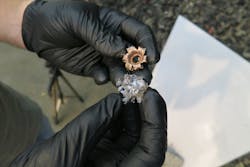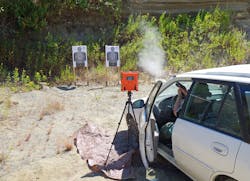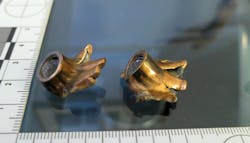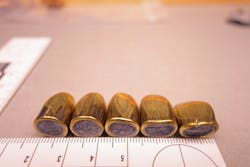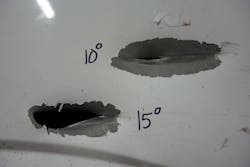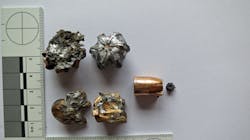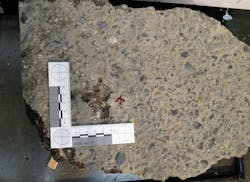As a shooter flees a homicide scene, pursuing officers PIT his vehicle, which flips and comes to rest inverted. Though the suspect opens fire from a window, returning fire to the upside down car from pistols and long guns is not immediately effective. The suspect is eventually wounded and surrenders, but not before he has fired over a dozen rounds.
How police bullets can rapidly resolve an encounter has been broadly dissected, particularly after an incident involving the FBI in 1986, commonly referred to as the Miami shooting. Words like stopping power, incapacitation and one shot stop, all made the law enforcement circuit, prompting extensive testing that was eventually referred to as the FBI Protocol. Expectations for law enforcement ammunition were arguably redefined after that event, but what are those bullets doing as they travel downrange and impact materials on the way to the target? For those tasked with the post-event analysis and putting together the pieces, success hinges on understanding bullet behavior and how they interact with objects during a gunfight.
‘Stopping power’
This is a highly debated topic that had been discussed before 1986 and long since. When FBI agents engaged the two bank robbers (Platt and Matix) in Miami, the suspects managed to stay in the fight, even after being wounded by agent gunfire. When the dust settled after well over 100 rounds were fired, the assailants eventually succumbed to their wounds, two FBI agents were dead and several more agents were wounded. The resulting investigation of the shooting event concluded that the wounds inflicted by the agent’s bullets where insufficient to rapidly incapacitate the suspects.
The agents’ weapons options, including the 9mm Luger cartridge, required evaluation and overhaul. Research, consulting with experts and scientific testing was ordered, all of which would comprehensively be known as the FBI protocol.
Born from this FBI testing was the 10mm Auto, with a fairly beefy wound profile and muzzle energies rivaling the granddaddy of duty handgun performance, the 357 Magnum. The 10mm would fall out of favor due to size and recoil, leading to the development of the 40 S&W cartridge. This cartridge was prominent in American law enforcement for three decades. As with most trends that tend to circle back, the 9mm Luger is making a resurgence on the hips of cops nationwide. This movement again stirs the debate on bullet performance in the field and places even more emphasis on event investigations.
FBI testing protocol
Where the FBI protocol really challenges bullet design is the evaluation of performance through laminated automobile glass – windshields and some side glass – and assessment of angular bullet impacts (different than 90°). An understanding of bullet performance related to these data points is critical when evaluating officer involved incidents. Most police departments make thorough and educated decisions for their selection of duty ammunition, either referencing prior ballistic studies or performing their own FBI type testing. But as with less lethal weapon selection mentioned in our August 2018 LET article found at Officer.com/21012614, some rely on the manufacturer without any thorough independent assessment.
Laminated glass - the kryptonite for lead and copper
Glass, especially laminated glass as found in automobile windshields and some side windows, is one of the most destructive materials to modern bullets encountered in shootings. The construction of this type of glass – two layers of glass with a plastic lumen in between – can often fragment and frequently change the path of bullets as they pass through, significantly altering the point of impact from the point of aim. Additionally, windshields are almost always sloped, further complicating its interaction with bullets.
Rifle bullets – the standard modern .223”/5.56x45mm designed for law enforcement AR platforms – are on the fringe of being frangible. Their primary intent is to prevent over penetration into a human target or stop in building structures should the bullet miss its intended target. This basic design presents a problem for barricaded assailants or something as seemingly simple as windshield glass. With AR platform rifle bullets, some nearly disintegrate after passage through this type of glass, showering the person with tiny bullet fragments. As with our opening example, this can also occur with various vehicle materials, where the underside of the vehicle was a perfect shield for all incoming rounds toward the suspect.Bullet deflection after interacting with a surface must also be considered. YouTube videos can easily be found instructing viewers to engage an assailant by shooting through their own windshield. Our testing, along with others, has revealed that a shot aimed at center of mass at normal traffic stop distances will often deflect, sometimes over the shoulder and downrange to parts unknown. Bullet fragments, even from bonded types, can be located in the dash of the vehicle as the bullet immediately starts to fragment as it passes through the glass. Several police agencies in our area have tested this technique and abandoned it in training. It is critical that this technique be thoroughly tested under realistic conditions with duty ammunition before incorporation into training.
Critical angle
For unyielding surfaces, such as concrete, the impact angle can mean the difference between a bullet that continues downrange after deflection (ricochet), or one that disintegrates. This angle can vary based on bullet type and the surface with which it interacts, but recovered bullets that have struck below the critical angle can be measured and compared to known angular impacts for reconstruction purposes.
Windshields again demand attention as their composition results in a fairly high critical angle, meaning the success of an engagement of a driver in a vehicle (bullets entering the passenger cabin) might simply depend on where the shooter is standing relative to the windshield surface. During one officer involved shooting we investigated, a 45 Auto caliber bullet deflected off of a passenger window due to its low angle of impact and quietly nestled under the weather stripping of the C-pillar. To the untrained eye these impacts will leave behind very little evidence on the glass. In fact, the detective was insistent that someone had rolled up the window prior to his arrival as it did not make sense that the window was not shot out.The bullet ‘autopsy’
When reconstructing shooting events, examination of the bullet is often overlooked by investigators or even scientists doing ballistic comparisons. Once bullets have left the barrel and flown through the air to their intended target, they hit stuff. For all of the scenarios discussed above, proper bullet examinations can prove, or at least corroborate, what the bullet struck. Anyone who has taken a basic crime scene investigation class should be familiar with or have at least heard about the Locard exchange principle.
Asking the questions for proper bullet selection
The primary design of modern law enforcement bullets is to interact with the human body and expel all of its energy into the target, with little chance of exiting. From a scientist’s point of view, the three major parameters for bullet performance are typically referred to as PEW (penetration, energy and weight retention).
But what if there is something in the way, such as a car? What is the expectation of bullet performance? What amount of research is invested in bullet selection for a particular application? For patrol? For special operations? For detectives with concealable firearms? As with everything, different bullet styles have their own advantages and disadvantages with bonded bullets in particular being chosen for law enforcement use.
What testing does your department do before new ammunition is issued? Is the FBI protocol followed? Are there protocols in place to compare field results if you switched to a different cartridge?
But most importantly, what analysis is done with bullets recovered from bodies or other objects? Are your crime lab scientists involved with ammunition selection and testing? Are they involved during post-event debrief on bullet performance of a particular incident? Is that knowledge passed along to the training department and the range masters? All of these questions should be considered when testing and implementing duty ammunition in order to help minimize surprises when applied in the field.
About the Author
R.T. Wyant, M.S. has been a forensic scientist since 1995 and specializes in firearm analysis and shooting incident reconstruction. He has examined several thousand bullets from both crime scenes and autopsies and consults on forensic cases all over the US and abroad. Wyant has been a reserve deputy since 2000 and is an internationally recognized expert in less lethal weapons.
About the Author
R.T. Wyant
R.T. Wyant is a supervising forensic scientist, reserve deputy and international expert on the testing, evaluating and the post-event analysis of less-lethal options. He has certified as an instructor in several less-lethal modalities and is a certified NTOA less-lethal instructor. He is the co-author of “Risk Management of Less Lethal Options: Evaluation, Deployment, Aftermath, and Forensics” (ISBN: 978-1-4665-6303-2).
